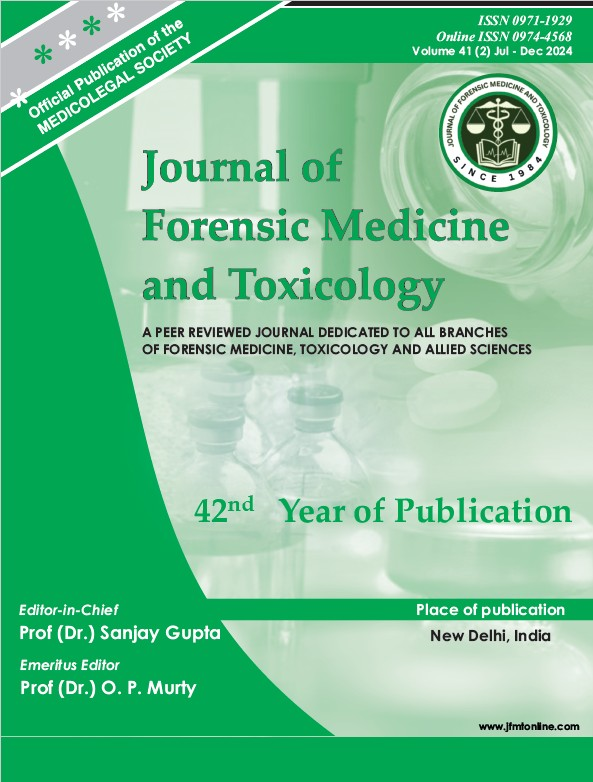BIOMETRIC SPOOFING - ARE FINGERPRINTS A RELIABLE IDENTIFICATION MARKER?
Keywords:
Biometrics, Artificial Fingerprints, Fingerprint Sensor, Silicon Mould, Wood Glue, SpoofingAbstract
Biometric spoofing has huge implications in today’s world where everything from our smart phones to border control and airports require our fingerprints to authenticate our identity. In this quasi-experimental study, we have attempted to create artificial fingerprints with the help of 20 volunteers. We have then tested these artificial Biometric recognition refers to the automated recognition of individuals based on their anatomical and behavioral characteristics such as fingerprint, iris, face and voice. Biometric technology is now routinely used as security systems in mobile phones, to prevent fraud in banks, for border security, and even by various countries to provide a National ID card (Aadhar card in India). Systems protecting confidential data require strong security to ensure only the intended person can obtain access. Biometry provides a user-friendly way to achieve this. These biometric systems have the advantage of not requiring you to memorize a password or carry any identification documents¹. There are many types of biometric recognition systems based on modalities such as fingerprints, iris, face, voice, DNA, gait, etc. But amongst all of these, fingerprints were found to be the most suitable in terms of uniqueness, universality, permanency, collectability, acceptability and performance2. Hence, fingerprint recognition systems are currently the most popular biometric systems in use all over the world.
Downloads
References
Available from: http://biometrics.cse.msu.edu/info/ index.html
El-Abed M, Charrier C, Rosenberger C, Evaluation of Biometric Systems, New Trends and Developments in Biometrics, 2012 November 28
Narayan Reddy KS, The Essentials of Forensic Medicine and Toxicology, 34th Edition, Hyderabad, India, Jaypee Brothers Medical Publication Ltd 2014
van der Putte T., Keuning J., Biometrical Fingerprint Recognition: Don’t get your Fingers Burned, IFIP — The International Federation for Information Processing, 2000, volume 52
Matsumoto T, Matsumoto H, Yamada K, Hoshino S, Impact of Artificial “Gummy” Fingers on Fingerprint Systems, Datenschutz und Datensicherheit, 2002 April, Volume 26
Nandini VV, Venkatesh KV, Nair KC, Alginate Impressions: A Practical Perspective, Conserv Dent, 2008 Jan-Mar, Volume 11, Page 37-41
Nayak SK, Pati P, Sahoo S, Nayak S, Debata T, Bhuyan L, Artificial finger with dental alginate impression can fool the sensor of various fingerprint systems, Journal of Indian Academy of Forensic Science, 2019 July 16, Volume 41, Issue 1
Available from: https://www.ccc.de/en/updates/2013/ ccc-breaks-apple-touchid, Accessed on: 02/10/2021 9. Available from: https://blog.talosintelligence.com/ 2020/04/fingerprint-research.html , Accessed on: 02/ 10/2021
Erdoðan S, Gülhan OT, Alternative Confidence Interval Methods Used in the Diagnostic Accuracy Studies, Computational and Mathematical Methods in Medicine, 2016 July 11
Sandström M., Liveness detection in Fingerprint Recognition Systems, Institutionen för Systemtechnik, 2004, Page 128
Alonso-Fernandez F, Roli F, Marcialis GL, Fierrez J, Ortega-Garcia J, Comparison of fingerprint quality measures using an optical and a capacitive sensor, First IEEE International Conference on Biometrics: Theory, Applications, and Systems, 2007, Page1-6
Adler J, Jain A, “Real or Fake? Creating fingers to protect identities”, MSU Today, Michigan State University, 2017 Sept 19
Available from: https://www.bayometric.com/ riskfactors-associated-biometric-identification/ Accessed on: 09/10/2021




